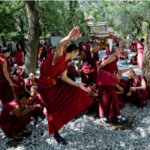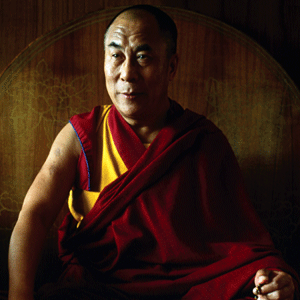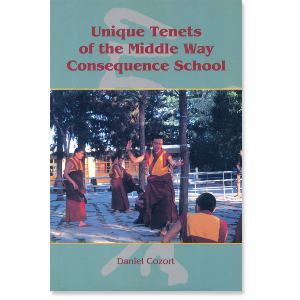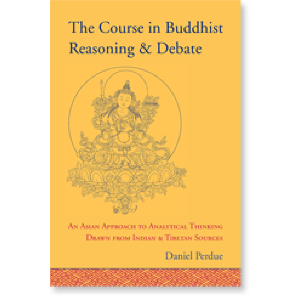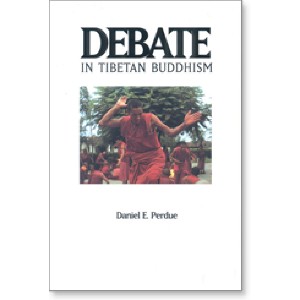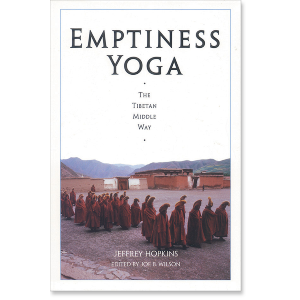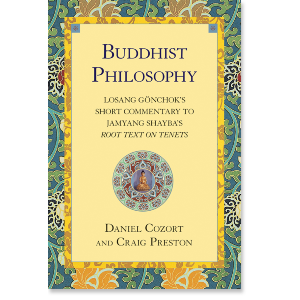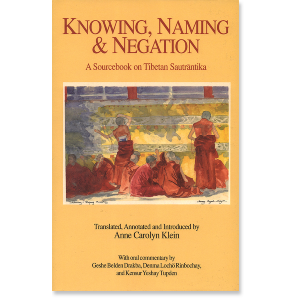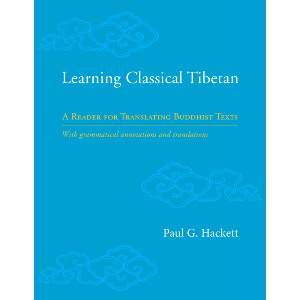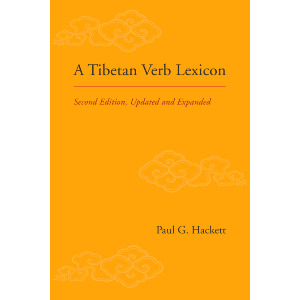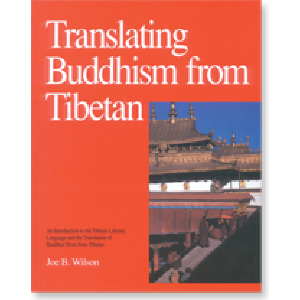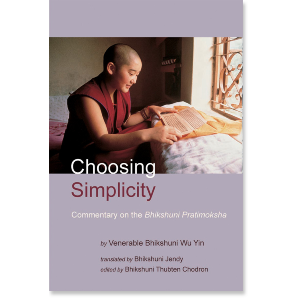| The following article is from the Winter, 2000 issue of the Snow Lion Newsletter and is for historical reference only. You can see this in context of the original newsletter here. |
Part I:
A Westerner's Glance Inside the Great Monastery of Sera Jey
by Devon Cottrell Holmes
some of the greatest practitioners of Buddha Dharma in the 21st century
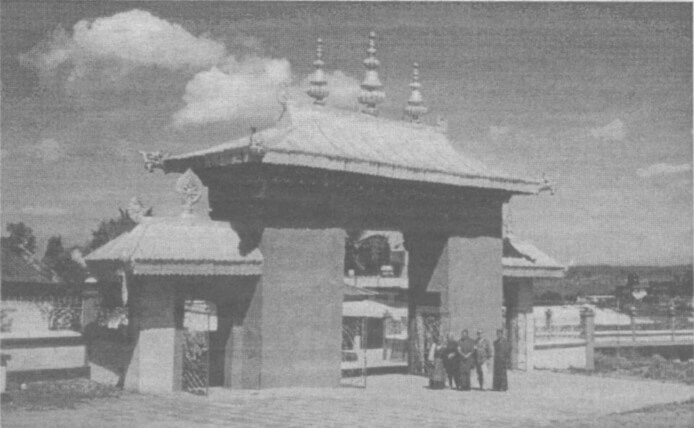
Entrance Gate to Sera Jey Main Assembly Hall
Introduction
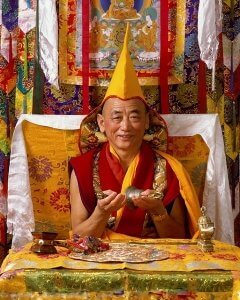
Geshe Lobsang Gyatso (1932-1998 Pacific Grove, CA)- born in Tibet in 1932 and was the head teacher and co-founder of Lion’s Roar Dharma Center in 1992.
While living in California, my husband and I met the Venerable Lama Geshe Lobsang Gyatso, a Tibetan Buddhist teacher. He had been born in Kham, Tibet and entered the local monastery at age 8.
Seven years later he journeyed to Lhasa and for 13 years studied at Sera Jey. When the Monastery was bombed by the communist Chinese in 1959, he fled to India.
When we met him, Geshe-la was in his sixties and living alone in a little house in Pacific Grove, California. He was in poor health and no longer actively teaching.
As his health declined, and it became apparent that he would soon die, he asked three of us to go to India on his behalf after his passing. He asked us to do an errand for him which involved a visit to Sera Jey Monastery in South India.
We prepared ourselves as best we could with shots, pills, passports, and permits and boarded a Singapore Air 747. We had no idea how deeply the visit would affect our lives.
Four thousand monks from both Sera Jey and Sera Mey were seated in the hall.
Arriving at the Monastery
We landed in Bangalore and the next day hired a car and driver. After traveling nearly six hours on the road to Bylakuppe, we took a turn off the main road and began to climb a low hill.
The road was rough and dusty. Along the road, we saw a group of red robed Tibetan nuns smiling and laughing and our car continued past the nunnery gates from which they had recently emerged.
Further up the road we saw clusters of buildings, trees and flowers. The car pulled to a stop near a cobble stone path next to a simple white building where a number of smiling Tibetan faces awaited us. At last we had arrived at Sera Jey!
We learned that at Sera Jey there are well over 400 qualified Geshes and 82 recognized Tulkus/Rinpoches who hold a high spiritual rank in the Tibetan Buddhist tradition.
Monks guided us indoors and offered us cool drinks and dinner. We entered the small dining room, off the front porch. In the middle was a table where about 10 people could sit. A thangka was hanging on one wall, a well-worn carpet was on the floor.
We were introduced to many people, and after dinner were taken to a small room in one of the Guest Houses. We fell into deep sleep after having agreed to awake at 4:00 a.m. for a Tara Puja.
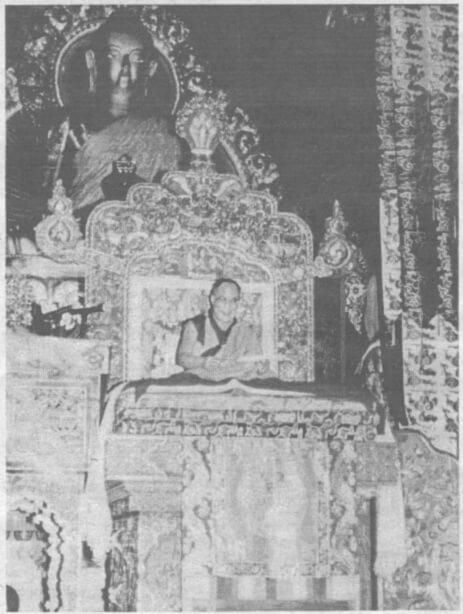
His Holiness the Dalai Lama giving teachings at Sera Jey
We walked in a procession behind the Abbot down the central aisle of the temple with chanting monks to the right and left in rows as far as I could see.
Tara Puja at Sera Jey Monastery
In the pitch dark we heard knocks on our Guest House door, and the early morning greetings of Lobsang Tenzin our traveling companion, as well as our new Tibetan friend from Sera Jey, Tenzin Dhonyoe, who had been selected to assist us.
Though Tenzin Dhonyoe was only in his early twenties, he spoke good English, had a lively sense of humor and the diplomatic demeanor of a world traveler.
We hastened to dress and entered the dark streets of the Monastery compound with our guides. Walking slowly and carefully on the cobble stones, hundreds of monks passed by us like rushing water on both sides, their rubber thongs slapping against their heels, and their heavy robes rustling and swishing in the dark.
Sera Lachi Assembly Hall
We were taken to the Sera Lachi Assembly Hall and mounted the many steps to the entrance of this large temple.
Four thousand monks from both Sera Jey and Sera Mey were seated in the hall. The Abbot was wearing his high half-moon shaped yellow hat.
We were handed tall bundles of incense and we held them in our right hand shoulder high. The holders were fluted columns about 12 long painted in the colors of the Dhayani Buddhas, with holes drilled in the top for the incense.
We walked in a procession behind the Abbot down the central aisle of the temple with chanting monks to the right and left in rows as far as I could see.
Making Offerings to the Buddhas
When we reached the altar, the statues and objects we were carrying were taken by attendants and we were handed kathas, the traditional white offering scarves, and envelopes of money offerings, to lay before a huge photo of His Holiness the Dalai Lama.
After making offerings there, we turned to the left of the central Altar and continued to the back wall on which, above us, was a row of huge statues in vast mahogany cases looking down from on high.
The statue of Shakyamuni Buddha was the largest and most central; Also present were Tsong Khapa, Padmasambhava, Tara, Maitreya, and Manjushri.
We were handed more kathas to hang before the giant statues. The railing on which we were to place the kathas was so high I had to stand on my tip toes and jump up a little to successfully toss the end of the katha over the railing, and pull it down. Once I understood how to do it, I was able to arrange the scarves so the ends were not trailing in the water bowls.
I wanted to pay respect, and hoped my first untutored efforts could be forgiven by the Deities who gazed down upon us. The statue of Shakyamuni Buddha was the largest and most central; Also present were Tsong Khapa, Padmasambhava, Tara, Maitreya, and Manjushri. There were others I did not recognize.
The Room of the Protectors of Sera Monastery
We turned to the right walking under the wall of Statues and entered the Room of the Protectors of Sera Monastery. The atmosphere was charged. Tantric practitioners were in the room with horns and other instruments blaring at full volume.
We again put offering kathas in front of the statues and filed out of the room and up the stairs to the second floor, horns blaring in the procession line. It was about 5:30 am. by now and still cool and dark.
We were seated along the edge of a series of huge windows. They did not look outside, however, but instead opened up to a view of thousands of monks, seated on their pillows on the first floor below us! The air was fresh, and we could feel the chill of the predawn morning. The chanting from the thousands of monks lifted up to the second floor and permeated everything with primal sound.
The chanting from the thousands of monks lifted up to the second floor and permeated everything with primal sound.
After chanting the monks dropped little scraps of paper in a bag that was being taken up and down the aisles by other monks. We were told they were voting for the new disciplinarian.
Sponsorship and Pujas
A man on the floor of the hall read from a huge list. It was a financial accounting for the expenses for the puja, and the names of the people who sponsored the puja! Monks went up and down the aisles distributing money. Each monk received 20 Rupees (about fifty cents U.S.$).
Pujas (religious rituals) which are sponsored by individuals not only allow the monks to meet and perform the rites requested, but pays for the supplies necessary for the pujas, and provides a little money for each monk. Pujas sponsored by wealthy patrons can even supply a meal, with rice, dal, and vegetables for each monk. It is a beautiful system, for the donors earn merit from their sponsorship in supporting the monks, and the monks benefit from the kindness of the patrons.
It is a beautiful system, for the donors earn merit from their sponsorship in supporting the monks, and the monks benefit from the kindness of the patrons.
At some point a few young monks jumped up, robes flapping as they ran barefoot out of the hall. They returned quickly carrying huge aluminium teapots. As if by sleight of hand, cups suddenly appeared in the monks' hands and they set them down in front of them on the floor.
As the teapot drew near, they lifted their cups and the buttery tea was poured. Then tall stacks of round flat bread were served. The server delivered the bread to the recipient as if gently tossing a frisbee. The monks then tore off small pieces of bread and dipped them into the tea. Some monks put the bread somewhere inside their robes.
On the patio upstairs, through the huge windows overlooking the hall below, we were served the same tea in pretty little teacups and saucers. Lobsang Tenzin pulled paper napkins out of his monk's cloth purse and passed them out. He had thought to bring them for his Western friends.
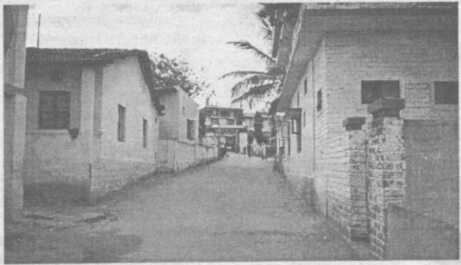
Streets of the monastery
The bread was soft, warm, and tasty. It was a flat bread about 6 in diameter which when dipped into the butter tea made a nice breakfast. I tentatively dipped the bread into the tea, having read stories about the salty butter tea of snowcapped Tibet. The butter was sweet, and it tasted wonderful with the delicious fresh bread.
The chant master's voice was very powerful, and the magical sounds of thousands of monks carried up to the balcony and mesmerized us with its exotic beauty.
A Tara Puja
Lobsang Tenzin of Gyuto Tantric College, who had met us in Bangalore, was seated next to me so I was happy to hear his whispered commentary on what was happening below us. I had never seen such a event. It was profoundly moving and vastly interesting.
A Tara puja was performed. The chant master's voice was very powerful, and the magical sounds of thousands of monks carried up to the balcony and mesmerized us with its exotic beauty.
It was still cool in the early morning air, and the sound of crickets chirping loudly melted into the sound of the chanting below. I was glad to have a wool shawl around me.
Life Lessons at the Lawa House
After the ceremony we went to Lawa house for another breakfast. We were served a more extensive western breakfast with coffee and jam and other delicious things.
It was not for a another day or so that we would realize that there was only enough money to feed the monks of Sera Jey one midday meal each day. Only when special pujas were sponsored (such as today) were additional meals possible.
A Tour of the New Sera Jey Main Assembly Hall
After lunch we went on a tour of the new building.
Through the beautiful and colorful arched entrance gate, stands a large, elegant building, in the traditional Tibetan style, painted pale yellow with a grand set of stairs leading up to the brightly painted entrance doors which were rich red, with beautiful details of lotus flowers painted in fine gold lines. The door had huge shiny golden brass hinges and was truly magnificent. The porch ceiling was highly decorated with ornamental wooden supports painted in blue, green, red, yellow and white. The work was masterful.
We walked down the massive central aisle and up to the altar bearing the photo of His Holiness the Dalai Lama. We passed behind it to the huge, perhaps ten times life-size statue of Lord Shakyamuni Buddha. As in the Sera Lachi Assembly Hall, other vastly tall statues were arranged to Lord Buddha's right and left. The new Assembly Hall also had a Protectors' room in the same location, and even unoccupied, the atmosphere in the room itself was pulsing.
In conversation with the chief administrators of Sera Jey we learned that through the profound generosity of donors from abroad, fluids had been sent to them earmarked specifically for the building of an Assembly Hall.
In the center [of the garden] was a monument to world ecology with quotes from His Holiness the Dalai Lama in a few different languages.
The Gardens
We took a tour of the Sera Jey Main Assembly Hall gardens. It was a lovely flower garden that could be viewed from the Dalai Lama's windows (rooms set aside for Him on the third floor of the building). There were many beautiful flowers in bloom, and a paved walk way through the gardens. In the center was a monument to world ecology with quotes from His Holiness the Dalai Lama in a few different languages.
The garden was for monks to come and absorb their studies, and relax. Monks do not participate in many of the activities that occupy most Westerners in their free time. So the garden was created as a beautiful, quiet recreational area.
We were told that the two elderly Geshes sitting on a bench talking were the ones who had created the garden.
The questioner was standing, hurling his questions both verbally, and physically at the seated opponent.
Tibetan Monastic Debate
In the sultry heat of the late afternoon sun, at the courtyard of the new Assembly Hall, were about five hundred monks debating. Many were jumping into the air, swinging their rosaries, slapping their hands and shouting.
The onlookers of each group of debating monks were intensely concentrated on the questioner, and the answers were delivered by the seated responder. The questioner was standing, hurling his questions both verbally, and physically at the seated opponent.
When the answers were wrong, the onlooking group laughed. When the answers were good the crowd smiled and slapped each other on the back. It was a lively, intensely focused activity with all the monks engaged in these vigorous debate groups.
the monks seemed poised in another realm, applying the reasoning of the great Buddha Dharma, enacting a 2,500 year old ritual of heightening the mind.
I felt conspicuous, camera in hand, wending our way through these groups of highly concentrated students of Buddhist dialectics. But the very athletic and enthusiastic monks hardly seemed to notice this group of curious tourists walking through their afternoon debates.
At the entrance doors, at the top of the vast staircase of the grand temple, the advanced students were debating. Against the brilliant red and gold doors opening into the great Assembly Hall, they seemed poised in another realm, applying the reasoning of the great Buddha Dharma, enacting a 2,500 year old ritual of heightening the mind.
The sound of the chanting monks was a beautiful harmonic chaos, an ancient musical sound. They were all reciting different texts.
Memorizing Texts
Tenzin Dhonyoe asked if we wished to see the monks studying. So at 9:00 p.m. we ventured out in the warm night air and walked to a vast concrete space under a roof where hundred of monks of all ages were grouped and in the process of doing recitations. There were different sized groups and occasionally a lone little monk sitting with his back up against a pillar studying a book in his lap.
One monk was so young, he could only have been five or six years old. He was reading all by himself. His tennis shoes were huge, and they looked incongruous sticking out of his beautiful red monk's robes. How could a child that young have so much composure, so little interest in the passing tourists?
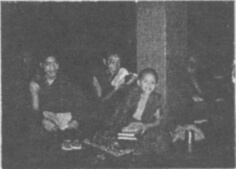
10-year old monk studying with tutors
Another young monk was about age 10. He was sitting with two older tutors. When I saw him he looked up and smiled cheerfully and went back to reading his book. He did not seem surprised to see a Western woman walking by with a camera during his study time.
How many Westerners had his little monk seen in his short life?
What was he reading that held his attention so profoundly?

Monks debuting in Courtyard
The sound of the chanting monks was a beautiful harmonic chaos, an ancient musical sound. They were all reciting different texts. They continued without stopping. Tenzing Dhonyoe told me they were memorizing texts.
I meandered through the seated crowds, like a lone seagull through the clusters of resting shore birds. No one seemed to mind as I snapped photos as I walked. I felt like an explorer having come upon a new land.
Who would believe a five year old monk studying alone?
Who would believe crowds of monks simultaneously reciting hundred of pages of text from memory?
the students who are studying at Sera Jey have the finest teachers as masters and role models.
We learned that at Sera Jey there are well over 400 qualified Geshes and 82 recognized Tulkus/Rinpoches who hold a high spiritual rank in the Tibetan Buddhist tradition. (Geshe refers to the title awarded for the completion of the most advanced program of training which takes about 20 years to accomplish.) Because of this the students who are studying there have the finest teachers as masters and role models. No wonder these students take their studies so seriously!
Under the sparkling stars we made our way back to the guest quarters.
We passed a building whose windows were yellow with electric lights. We pressed our faces up against the dirty windows to see a few Tibetans at looms weaving beautiful rugs. Tertzin Dhonyoe said it was a rug factory. Maybe the cool night was a pleasant time to work.
Duk-kar Puja
Up at 4:00 a.m. for a Duk-kar Puja at the new Assembly Hall with 3,000 monks from Sera Jey. We made our way in the dark again.
Monks ran down the darkened streets. The shadows were filled with the glint of maroon robes, and the sound of sandals slapping, flooding up the endless steps to the cool marble landing, flowing through the temple doors like sand through an hourglass.
I saw a sea of rubber sandals on the steps and landing. I wondered how do they find their own sandals? Do they wear any pair?
After the puja, we emerged from the red temple doors at sunrise, and standing on the landing looking out over the wide expanse of land toward the east, we saw in front of us a vista of distant grey-green hills rising against a rose pink sky.
In the Abbot's Quarters
We were introduced to the Abbot in his personal quarters on the second floor. It was an informal meeting with Geshe Jampa Theckchhog and he was seated at his desk with a cup of tea.
The room had a beautiful view of the distant hills, and the sturdy desk had the well used look of someone familiar with paperwork. I felt at home.
He asked us about our friend, the late Geshe Lobsang Gyatso of Pacific Grove, California, and asked if he suffered before he died.
The Abbot is a large man with a wide smiling face and a wonderful, kindly presence.
When I began to cry, he handed me a brown shaggy rock and was chuckling. I was thoroughly surprised. I looked at the rock, and looked back at him. Again, he was pointing to the side of the thing, and smiling.
I stared hard at the object and realized it was a coconut. And furthermore, it had markings on it that looked like a face! I got the joke, and smiled, grateful for the well-meant distraction.
He leaned back and we continued the conversation. We thanked him for the hospitality, and told him how grateful we were to be there, and what a wonderful experience it was. The Abbot is a large man with a wide smiling face and a wonderful, kindly presence.
I realized we had entered a mysterious world, of which I knew very little, and we were getting in deep.
Stories from Geshe Thinley
Geshe Thinley has a presence. It felt as if he was smiling even when he was not. A benign atmosphere seems to perpetually surround him. This Tibetan Geshe is tall and lean, with a thin handsome face so universal he could have been born anywhere. He is an administrator of the mid-day meal program.
Geshe Thinley spoke through a translator. He told us that of the remaining original 250 old monks from Sera Jey Lawa Khangsten in Tibet, there were only a few who were still alive. (I think he said 13.) This interested us since our late friend on whose behalf we had agreed to do this errand at Sera Jey had reduced this number by one.
Geshe Thinley said for us not to be concerned about Geshe Lobsang Gyatso with regard to finding his incarnation, because He will be able to recognize himself. I realized we had entered a mysterious world, of which I knew very little, and we were getting in deep.
Geshe Thinley told us,
"I hope that those well-known and well educated teachers can reincarnate and will help in future to spread Buddhist philosophy and work for peace."
The translator continued,
"Geshe Thinley is 65 years old. Instead of relaxing and retiring he continues to work hoping that those people who are trying to get here and study will be able to do so and spread Lord Buddha's teaching. He has the courage and inspiration to do more hard work. We have appreciation of our studies and so those students who are still young I hope they can do the same things that the old great Lamas did."
The translator continued,
"When the new arrivals come he tells them:' Think of your studies. Don't think about material things. They can't take away your studies. Studies is the main business.' He used to advise like this," said the translator. "He tells his students: 'Get one particular piece of knowledge and study it well. Then we can take it back to our homeland. When you study your first destiny is to become a Geshe. Then you go higher and higher and you can give verse. Keep your ambitions to get a Geshe degree and then study tantra."
"This is what he tells his students: 'Aim to finish your Geshe degree.' If a student can't get on with his studies he would say: 'OK, you can't do the studies, but listen to your teacher and take part in monastery activities and be a simple monk and help Lawa Khangsten (Lawa house) monks by giving physical help to the other young monks. If this happens it will be beneficial to Lawa Khangsten."
Puja at the Lawa Khangsten Assembly Hall
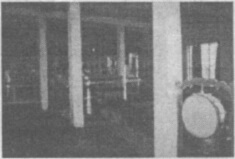
Assembly Hall for 130 Monks Sera Jey Lawa Khangsten Small
We were invited to sit on the meditation cushions along the back wall of the hall.
This was a small Hall used just by the 130 monks of Lawa Khangsten. The monks were seated in rows in the Hall.
Geshe Chosang Rinpoche was seated in the high seat. The monks chanted the Prajnaparamita Sutra.
The afternoon sky was turning golden yellow.

Sera Jey Monastery from a distance
Sera Jey Monastery: A View from the Rooftops
We walked the quiet dirt streets around the monastery passing some pretty houses with gates, and long concrete buildings with fabric covered doorways, waving in the breeze. Some were monks quarters. Monks were in the yard resting. It was a happy atmosphere.
We climbed inside an unfinished building and got to the roof. It offered a sweeping view of distant hills, puffy white clouds, miles of green fields, and a superb view of the new Sera Jey Assembly Hall.
It was a beautiful day, and the sight of the golden yellow temple spires was breathtaking.
I was fascinated to learn that Sera Jey had bought a small plot of land on which they planned to put up a small house for the late Ven. Geshe Lobsang Gyatso of California. Clearly they were expecting him back. I could see the plot of land from the roof.
Would people get to see Geshe Lobsang Gyatso again in a new body? According to these Lamas it was likely to happen.
Geshe Chosang Rinpoche said,
"In my opinion he will come back to Sera."
We clambered over the lumber and concrete blocks from the construction in progress, and made our way down the road.
His features are nearly perfect, like those sculpted on ancient statues of the Buddha.
A Meeting with Geshe Tenzin Chosang Rinpoche
Down a shady tree covered walkway, the path opened on to the concrete walkway in front of a single room with a colorful yellow, red, and blue Tibetan curtain hanging over the doorway. Tenzin Dhonyoe and I removed our shoes and stepped into the room.
There was a table, a bed, a rug, and a few books. The room was spare. Rinpoche greeted us graciously as we sat down on the rug. I had met Rinpoche a few days before and I was happy to see him again.
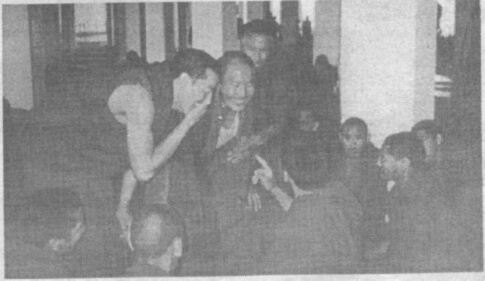
Monks laughing at debate
Rinpoche has a remarkable countenance. His features are nearly perfect, like those sculpted on ancient statues of the Buddha. His eyes are beautiful and curve in a perfect almond shape usually seen only on idealized statues. The corners of his mouth curve upward and the edges are clearly defined. His carriage is noble and he has an elegant bearing.
He is 32 years old and is a full Lharampa Geshe. (There are four levels of the Geshe degree and he is at the highest.)
Geshe Thinley was also there. Geshe Thinley does not speak English, so Tenzin Dhonyoe would occasionally stop to translate.
My belief in reincarnation solidified into a concrete certainty as I grasped this chronology. Rinpoche spoke from a vast perspective.
Rinpoche speaks beautiful English. He was one of the teachers of Geshe Lobsang Gyatso (of Pacific Grove, CA) in his (Rinpoche's) former life. Rinpoche's name in his earlier life was Geshe Jampa Choephel. I was aware of how curious it was, talking in English, to the reincarnation of one of Geshe Gyatso's former teachers.
My belief in reincarnation solidified into a concrete certainty as I grasped this chronology. Rinpoche spoke from a vast perspective. When he answered questions, the responses were like time release capsules that continued revealing meanings over time.
When the interview ended, Rinpoche gave us some gifts to distribute, we paid our respects, and Tenzin Dhonyoe and I continued our walk.
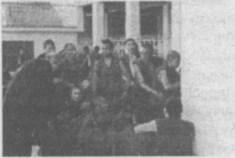
Sera, Jey senior monks in discussion
Sera Jey–the seriousness and dedication with which the monks, Rinpoches, and Geshes are engaged in the formal study, practice, and teaching of Mahayana Buddhism. . . we would not forget.
Hope for the New Millennium
Upon our return to America we could not forget Sera Jey, and the seriousness and dedication with which the monks, Rinpoches, and Geshes are engaged in the formal study, practice, and teaching of Mahayana Buddhism.
Historically, many great teachers and spiritual adepts have trained at Sera Jey. These great beings continue to reincarnate and find their way back to Sera Jey to be trained again and continue their selfless work for mankind.
The Tibetan Buddhist tradition brutally destroyed in Tibet and displaced to India is now being offered to the wide world. His Holiness the Dalai Lama, one of the foremost citizens of The Global Village has worked and traveled tirelessly for three decades to help this happen. We are all heirs to the legacy.
All 3,000 monks pray each day for the welfare of all beings on the planet.
The rebuilt Sera Jey Monastery is an important milestone both materially and symbolically of mankinds' movement in time toward a new and better world. The monks of Sera Jey have made a heroic effort to keep the Good, the True, and the Beautiful alive. All 3,000 monks pray each day for the welfare of all beings on the planet.
Sera Jey Monastery is arising like a flower pushing up through desert rock, as if driven to grow by nothing but pure sunlight.
I believe, from firsthand observation, that Sera Jey Monastery will again reach the proportions of its great original in Tibet, and will constellate from its midst some of the greatest practitioners of Buddha Dharma in the 21st century.

